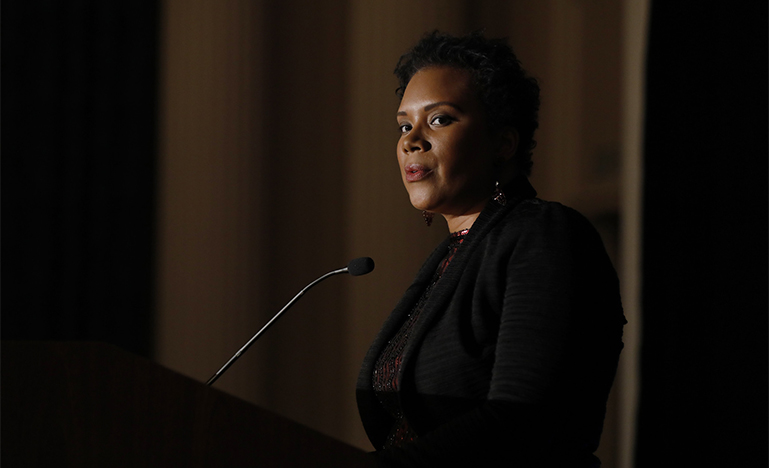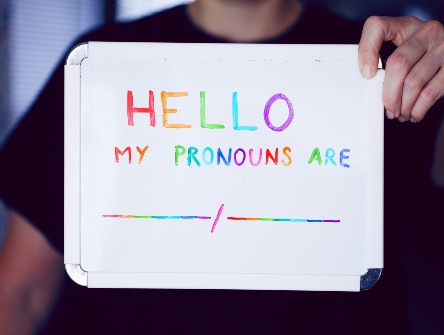Five lessons in authentic Black leadership
To commemorate Emancipation Day, we are publishing the script for a presentation delivered by CBA President Vivene Salmon to the Ontario Ministry of the Attorney General on February 25, 2020, as part of Black History Month.

Good afternoon everyone.
Before I studied law I worked for the Government of Ontario in the offices of several deputy ministers. I also did a short stint at the Attorney General in the business group through the young professional program, so I understand something of the environment in which you operate.
The Government of Ontario, like many institutions and businesses, struggles with the question of racism.
It has passed legislation, and put a framework in place to identify the kind of systemic racism that keeps racialized public servants, and equity-seeking Ontarians in general, from achieving the same kind of success as their white counterparts.
People of colour are as likely to come up against systemic bias in Canada as outright racism. We’re all biased, it’s in our DNA. It was an advantage to us in the earliest days of humankind to be able to recognize friend from foe. Problems arise when we become aware of our biases and continue to act on them anyway. When we fail to correct the error of our ways. Unfortunately, it’s often left to people of colour to interrupt the bias of those who hold the power in order to advance.
I was invited here today to talk to you about authentic leadership. The internet is awash in articles telling us the five steps – or seven – or twelve – to take to be a good leader.
The number of steps is even harder to pin down for racialized leaders, because authenticity has a whole other subtext for people from different equity-seeking groups.
I’m not going to pretend I have all the answers, but I’ve identified what I’m going to call five lessons for leadership.
Lesson #1: Be resilient
I was reminded of the first lesson when I learned I was in line to be CBA president.
My parents immigrated to Canada from Jamaica to give their children a better life. They taught me and my brothers to value education for the opportunities it can open up, for the places it could take us. It took me first to a career in government communications, and then to the law. I’m currently on leave from my job, where my title is Vice-President, Country Compliance Manager, Global Banking and Markets Compliance at Bank of America Merrill Lynch.
I’m only the tenth female president, and the first president of colour in the Canadian Bar Association’s 124 years of existence. I’m here thanks to the paths blazed by the people who came before me. I’m also here because I worked hard to get into a position where it was possible to seek out and then take on leadership roles. So when the news came that I’d been named vice-president, I felt like I’d achieved something that I’d worked for. I was pleased and proud, so were my friends and family.
But one of the first comments I heard when my path to the presidency was announced was, “It should have gone to someone who deserved it.” To be fair, there are any number of reasons why someone might think I didn’t deserve it – maybe they thought I lacked the requisite experience. Maybe they thought I was too shy and soft-spoken. Or, and this has to be considered, maybe they didn’t think a young Black woman was up to the task.
The CBA is a progressive organization, it talks the talk about equality and diversity and, in my experience, it is also sincere about walking the walk. Living up to our aspirations, however, is a marathon, not a sprint, and not everyone standing on the sidelines is cheering you on.
There is enormous pressure on anyone who is the first, or the only one, of their kind. Michelle Obama talks about knowing her family would have to be above reproach for the time her husband was in office to prove that a Black president could succeed with honour. To protect the path for the next president who wasn’t a white man.
I’m not exactly in the Obamas’ position, but I feel the pressure of wanting to refute the stereotypes and clear the path for the next person of colour. Unlike the Obamas I can see who’s coming up behind me – Charlene Theodore, who will be the first Black president of the OBA come September.
And my current vice-president, Brad Regehr, who will be the CBA’s first Indigenous president. I’m very conscious of not wanting to leave a burden for either of them to carry.
Harvard Business School recently did a study of its graduates. Of the 2,300 Black people who have completed the program, just 67 were women who went on to rise to top positions in U.S. corporations.
Those 67 women all had one thing in common: resilience. They were able to come back from the setbacks, view them as teachable moments, take on board what they needed to take on board and – most importantly – MOVE ON. In the words of novelist Toni Morrison, “You wanna fly, you gotta let go of the shit that weighs you down.”
So, my lesson #1 for leadership is: Be resilient.
Here’s the downside of that lesson: the things that make you a good lawyer, like skepticism, suspicion, and pessimism, make you the opposite of resilient.
Dr. Larry Richard is an organizational psychologist and author of The Lawyer Brain. He says it is possible to reroute your neural networks and become more resilient, but it takes work and the will to do it. Things are not always going to go the way you want them to. You can’t choose every outcome, but to a certain extent you can choose your reaction to a particular stimulus. If you can find a way to remain optimistic in the face of insult or disappointment, you will be on your way to resilience.
Lawyer coach Paulette Pommells says being overworked and exhausted doesn’t build resilience. She suggests that you approach resilience-building like a workout routine: try really hard, stop, recover, and then try again.
Lesson #2: Make friends
There’s an old saying: who you know is more important than what you know. And this is as true as it ever was. Racialized lawyers in Ontario have identified the absence of professional networks as disadvantage to their careers.
And that’s because according to a University of Toronto study, racialized students are more likely than their white counterparts to be first-generation immigrants, their parents are more likely to be blue-collar workers. More than 10 per cent of white respondents said their father had completed law school while fewer than two per cent of racialized respondents said the same. They haven’t been born into the kind of professional classes that give you a built-in network of contacts and people who can act as sponsors.
That study of successful Black female Harvard graduates found another key to their success was the people around them – people who believed in them despite their mistakes. People who gave them constructive feedback. People who made it their business to create opportunities for them.
So who is there to help you?
Look around you. We’re all members of a host of professional and personal communities.
I can name five of mine without even trying: lawyers, in-house counsel, Black lawyers, women lawyers, Black women lawyers. I can say that every one of my communities has had a part to play in getting me to where I am. They’ve taught me things I need to know. They’ve reinforced my confidence that I’m on the right path.
Lesson #2 is to build and nurture your communities.
When we’re facing obstacles like systemic racism or even unconscious bias, personal and professional networks, encouraging voices, mentors – and better yet, sponsors – are critical to our success. Those relationships don’t just fall into your lap, though, and you limit your opportunities when you don’t do everything you can to create them.
I’ve heard it said that lawyers are in the business of relationships. No matter where you are in your career, you need to make a point of introducing yourself, make a point of getting together. Insert yourself into groups that you see value in joining.
Even if it looks like you have nothing in common.
We’re all people, people like to be noticed. Send personal notes, forward interesting articles, interact in multiple ways.
And do this both within and outside of your ministries and industries. I’ll put in a plug here for the CBA – it’s a great way to get to know and network with lawyers in a variety of fields. Pay attention to the people who have what you want and make a point of getting to know them. Find out where they like to eat, invite them to lunch and come prepared to talk about things they’ll find interesting, so they’ll find you interesting. Get to know them, learn the recipe to their secret sauce.
Carla Harris, an investment banker with Morgan Stanley, one of the few Black women to make it to the top on Wall Street, talks about two types of currency you can create and spend in the workplace. The first is performance currency – you create that by delivering above expectations.
The second is relationship currency.
You create that by investing in the people in your environment, connecting and engaging with them, and giving them the opportunity to know you. Especially if they can be helpful to you as sponsors.
So when someone asks how they can help, make sure you have an answer.
And when someone asks you for your help, be smart enough to pay it forward. Carla Harris says you create your power by giving it away.
Lesson #3: Build emotional intelligence
The first two lessons, being resilient and building communities, lead directly into Lesson #3: work on your emotional intelligence.
Unlike IQ, which is a numerical measure, EQ, or emotional intelligence, is gauged by your ability to empathize, communicate and interact with others.
Being emotionally intelligent means being self-aware – having confidence in your abilities and also being aware of where you need work. It means being able to regulate your emotions. That doesn’t mean you don’t get to have any emotions at all, you don’t have to become a block of ice. But you do need to manage emotional extremes in a healthy way. It also means taking responsibility for your performance, being trustworthy and conscientious. Having clear goals and a positive attitude. It means being able to empathize with others, to read their signs and react appropriately.
A healthy EQ is vital for any lawyer who intends to disrupt the basic model of big-firm culture, which traditionally celebrates white, heteronormative, masculine traits. And it can help you choose the right firm to work in.
Often you can’t afford to be picky about the job you take, especially right out of law school when you have loans to pay. But when you have the luxury, make your choice an informed one. You can’t really know how you’ll react to a situation until you’re in it. But doing your homework about a prospective firm, knowing your own strengths and limitations, their style and how that might mesh with your style, can help you narrow your choices down to workplaces that are more likely to suit.
In this profession it’s important to bring your whole self to work – your whole commitment, your whole attention, your whole skill-set, every day. You need to have the strength to walk away if you can’t do that. On the other hand, if you are working at your dream job, maybe it’s worth it to try to change things. It is in the firm’s best interests to ensure that all employees are engaged and committed, after all. Just remember that employers are more likely to act on a solution than a complaint.
Lesson #4: Authenticity
How you fit in to the culture of the workplace has a lot to do with authenticity. Authenticity is staying true to yourself by acting in accordance with your principles.
Within any kind of organization, some level of conformity to the culture is necessary.
But often people of colour have a “working identity” – we compromise or negotiate with our sense of self to “pass” as what is more acceptable – changing our dress, our hair, or acting explicitly to negate cultural stereotypes.
Ritu Bhasin, author of the Authenticity Principle, says the problem with the kind of systemic bias that people of colour face in the workplace is that we internalize it, and it manifests itself in our thinking as imposter syndrome. It causes us to change our behaviour, to change who we are. We mask our identities and start performing a curated image of who we think others want us to be.
She also says no one can be authentic 100 per cent of the time. We’re always calibrating ourselves, our behaviour, for our audience. For example, would you swear in front of your grandmother? On the other hand, suppressing too much of your authentic self for too long can result in isolation, alienation and disengagement. It can have a harmful effect your performance and even your physical and mental health.
The question is: To what degree do we need to calibrate?
So Lesson #4 is: learn how to flex your authenticity.
Think of it as bringing the right tools to the right audience at the right time.
Black women in particular are often told their personality is too strong, or their clothing or hair choices are inappropriate. Black men are told they’re too intimidating.
Cynt Marshall is the CEO of the Dallas Mavericks. She’s the first Black woman to lead an NBA team. She says she checks out the workplace first and judges what it’s ready for.
That said, she says you can show up as your authentic self on Day 1, but you need to know how to manage the risk if being your authentic self is going to be risky.
Insofar as you can, don’t work for a firm that doesn’t encourage you to be the person you are when you wake up in the morning. Be smart about the company culture you choose to work in.
And regardless, don’t try so hard to fit in that you become average. Be confident in what you bring to the table, and don’t let anyone suggest they’re doing you a favour by giving you a seat.
Lesson #5: Hone your executive presence
That brings us to today’s last lesson.
Hard skills, qualifications and abilities will get you in the door. But if your goal is to reach the top – and this is true for everyone, including white men – you need the “wow” factor known as executive presence.
Research by the Center for Talent Innovation in the U.S., however, shows that this “wow” factor presents a big obstacle for women and professionals of colour, for a variety of reasons – either because they lack executive presence, or because they underestimate its importance. And of course because standards of appropriate behaviour, speech and dress are set by white men. So people of colour who already feel like they have to work harder than their white counterparts just to be perceived on a par with them also feel they are held to a stricter code of executive presence standards.
The good news is that while you have to be born with looks and talent, executive presence is something you can learn.
So lesson #5 is to take all of the other lessons – resilience, relationship-building, emotional intelligence and authenticity, and use them as a foundation on which to build your executive presence.
Sylvia Ann Hewlett literally wrote the book on executive presence in 2012. She identified its three main components as gravitas, communication and appearance. And all three of those things can be wrapped up in another word: confidence.
Surveys suggest that if you have the right stuff, it’s less important that you conform physically to the expectations of a leader. And that’s good news for people who often hear that they “don’t look like a lawyer.” That said, you also need to dress for the job you want, to project the image you want people to see. That’s not so much about a certain style as being respectful to the context you’re moving in.
At its core, executive presence is about your ability to build trust. For people to be confident in you, you must first have confidence in yourself.
Think of it this way – you’re going to make an impression regardless. Approach that inevitability with intention.
Can you be authentic and still have executive presence? That’s a good question, and it’s one that thought leaders are still grappling with. The key, I think, is to live your values. Bring your best self to work every day insofar as you are able. Have confidence in your value proposition, understand how to build your own strategy and how to communicate your vision and goal.
Those are my five lessons in executive leadership.
Diversity initiatives and anti-racism strategies are moving the bar forward for racialized professionals. Slowly. Incrementally.
There are things we can do try to move it faster. It’s not always going to work, and that’s just a fact. But I’m living proof that it does move. I’ve talked about others who’ve seen it happen, or made it happen for themselves. Remember your communities, and pay your success forward.
Authentic leadership resources
We are providing a list of resources consulted for this presentation (all resources available in English only), and given time can provide a footnoted text on request. The presentation included an audience-participation component which is not included here. (Check against delivery).
Reports
Law and Beyond: A National Study of Canadian Law Graduates, by Ronit Dinovitzer, University of Toronto, American Bar Association. June 7, 2015
But I was Wearing a Suit, a grassroots project of a group of Indigenous Lawyers, with the support of the Continuing Legal Education Society of BC and the Law Society of BC.
Diversity by the Numbers: The Legal Profession, Canadian Centre for Diversity and Inclusion
No One Looks Like Me: Diversity on the Bench, by Justice Linda Lee Oland of the Nova Scotia Court of Appeal, July 8, 2016
Out of the Closet and Up the Ladder? Diversity in Ontario’s Big Law Firms, by Asher Alkoby and Pnina Alon-Shenker of the Department of Law and Business, Ted Rogers School of Management, Ryerson University, published in the Windsor Yearbook of Access to Justice, 2017
You Can’t Change What You Can’t See: Interrupting Racial and Gender Bias in the Legal Profession (Executive Summary), by Joan C. Williams, Marina Multhaup, Su Li and Rachel Korn of the Center for Worklife Law at the University of California, Hastings College of the law, written for the American Bar Association’s Comission on Women in the Profession and the Minority Corporate Counsel Association.
Key Concepts – Equality, Diversity and Inclusion, Working Together for Change, Law Society of Ontario
Articles
Why relationship currency matters, by Carla Harris, LinkedIn, March 25, 2015
Most people are focused on the wrong measure of success, by Vivian Giang, Fast Company, April 23, 2019
Maximize Your Career Success: Pearls from Carla Harris, by Lauren Foster, CFA Institute, May 26, 2017
Carla Harris: Carla’s pearls (videos)
How to find the person who can help you get ahead at work, by Carla Harris, TED Talk, December 2018 (video)
Three Pillars of the Authentic Self, by Ritu Bhasin, The Lavin Agency, March 29, 2017 (video)
Leadercast Women 2018: Ritu Bhasin on the Authenticity Principle, Leadercast, January 25, 2019 (video)
Want to Live More Authentically? You Must Use This Transformative Tool!, by Ritu Bhasin, August 2, 2019 (blog)
First-ever leadership bootcamp for racialized lawyers a success, by Kim Covert, CBA News, June 11, 2019.
“R” is for Bob Dylan’s “Resilience,” by Paulette Pommells, Attorney With a Life, 2017 (blog)
Seven ways to develop your leadership style, by Michelle Braden, Forbes Coaches Council, Forbes.com, March 13, 2018.
Black Business Leaders Series: Oprah’s Path to Authentic Leadership, Cold Call podcast with Bill George, Working Knowledge, Business Research for Business Leaders, Harvard school of Business, Feb. 1, 2018.
When It Comes To Authentic Leadership, It's Time To Wise Up, by Kevin Kruse, Forbes.com, March 5, 2018.
Double Discrimination & Intersectionality, (video), leanin.org.
Beating the Odds, by Laura Morgan Roberts, Anthony J. Mayo, Robin J. Ely and David A. Thomas, Harvard Business Review, March-April 2018
Diversity and Authenticity, by Katherine W. Phillips, Tracy L. Dumas and Nancy P. Rothbard, Harvard Business Review, March-April 2018.
More research needed to break down job barriers for racialized Canadians, by Eddy Ng and Suzanne Gagnon, Policy Options, January 24, 2020
Leadership Styles of Ethnic Minority Leaders, by Innocent F. Okozi, MA, Kimberly L. Smith, MA, Le Ondra Clark Harvey, PhD, and Regina M. Sherman, MS, American Psychological Association, Communique August 2009.
Can you be your authentic self?, by Fernando Garcia, Canadian Lawyer Magazine, June 3, 2019.
Black on Bay Street: Hadiya Roderique had it all. But still could not fit in, by Hadiya Roderique, Globe and Mail, Nov. 4, 2017
Authentic leadership: To thine own self be true, Insights.
What Resilient Lawyers do Differently, by Paula Davis-Laack, Forbes.com, September 27, 2017.
The untold history of the legal profession, by Mai Nguyen, Precedent Magazine, December 4, 2018.
Why Women and People of Color in Law Still Hear ‘You Don’t Look Like a Lawyer,’ by Tsedale M. Melaku, Harvard Business Review, August 7, 2019
You Don’t Look Like a Lawyer: Black Women and Systemic Gendered Racism, by Tsedale M. Melaku (Rowman & Littlefield, 2019).
Navigating the corporate space as women of colour, by Sandra Goodwin, CBA National, October 29, 2019.
Bringing your authentic self to work as a Black woman – Unpacked, by L. Michelle Smith, Black Enterprise, March 5, 2018.
African Canadian Leadership: Continuity, Transition, Transformation, edited by Tarmari Kitossa, Erica S. Lawson and Philip S.S. Howard (University of Toronto Press, 2019).
Colour-coded Justice: What's a Black lawyer to do?, by Anthony Morgan, Canadian Centre for Policy Alternatives, September 3, 2019.
Tips for developing your executive presence, by Jennifer V. Miller, The Economist Executive Education Navigator.
What is Executive Presence and How Do You Get It?, by Nicole Lipkin, Forbes.com, July 11, 2019.
Executive presence: what it is and why it's important, The Ivey Academy.
The Science of Influence: The Three Dimensions of Executive Presence, by Suzanne Bates, Bates Communications, December 5, 2013.
Cracking the Code That Stalls People of Color, by Sylvia Ann Hewlett, Harvard Business Review, January 22, 2014.
Boss Habits: 5 Steps to Boost Your Executive Presence, by Michelle Awuku-Tatum, Black Enterprise, February 18, 2015.
Opportunity at the Crossroads: Using Authentic Leadership Presence to Interrupt Unconscious Bias, Legal Council on Legal Diversity 2017 Mid-Year CLE Seminar and Webinar, meeting overview.
Improve your executive presence: Stanford GSB lecturer and coach Alison Kluger teaches nascent entrepreneurs how to communicate like a leader, by Mary Duan, Insights by Stanford Business, September 27, 2017.
Decoding Executive Presence: 3 Way To Improve Yours Today, by Ravi Raman (blog), January 11, 2017.
What women, people of colour need to land top jobs, by Dr. Hume Johnson, Jamaica Observer, January 27, 2019.
What is Authentic Executive Presence?, by Melanie Munoz, MA, CDP, LinkedIn
Executive Presence: A How-To Guide, by Luke Visconti, Diversity Inc., November 6, 2014.
Black GC 2025 Interview: How to Master Executive Presence Skills, Thomson Reuters, Legal Executive Institute
Members on Issues: Executive Presence and Equity Leaders: Contradictory or Complementary?, by Chao Yang, Emerging Practitioners in Philanthropy, October 23, 2017.


